As the penultimate kicked off this morning, the conference saw the delegate participation hit a peak. Being the busiest day of the conference, the day attracted hundreds of testing professionals eager to get a slice of the action.
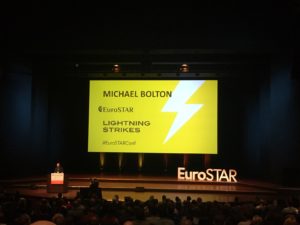
Lightning Talks
This very interesting format brought five eminent speakers in testing to the stage with a strict time limit of 5 minutes each to deliver a lightning talk.
Michael Bolton was up first picked insightful observations from a bug report from the airline industry and highlighted the quirks around how the experts in aviation captured the details around a bug. He further elaborated on how aviation mishaps have been staggeringly low in the last 20 years. “They learn from every bug” he concluded giving the audience a lot to think about.
Isabel Evans was up next spoke engagingly about her experience of learning to drive and how she overcame her apprehensions around it. She shared with us the mantra that her driving instructor gave her – steer in the right direction, adjust the speed and then adjust the gears. Likewise, she said, give yourself physical, emotional an intellectual time to get aligned in the right direction, change the speed comfortable to you and then change the gears. “It works in driving, IT projects and in life!” she said.
Test automation expert Seretta Gamba was third to go on stage. She drew a very interesting analogy between a cat and automation testers. She said a lot of the cat characteristics would suit an automation testing role – for example being lazy (hence produce scripts instead of manually repeating a task), being curious (always trying to look for more information in the systems / requirements), clean (always attempting to refactor the automation code), give feedback (actively communicate with developers, managers etc.) and cautious (keeping a strategy to automation). “Find a cat and follow his lead to be a successful automation expert!” she concluded.
Agile specialist Fran O’ Hara was the fourth who explained the difference of three different scenarios of testing practices in an agile implementation. Testing in the subsequent sprints, he said, causes interruptions, testing in the same sprint still would feel like a waterfall implementation but testing in the same lifecycle, with fuller integration would bring the best results. Unfortunately Fran could not get to the conclusion as the ‘lightening struck’ and time ran out!
Alan Richardson was the final speaker who spoke about how testers often complained about not being given enough time, enough information, not being taken seriously etc. He said that the best way to respond to it is to share the pain and use agile techniques to clearly establish testing issues. For example, effectively carry out exploratory testing and use agile terminologies to communicate the issues so everyone can see a reason to change their approach to testing. “Make it clear” he said.
Key Note Speech
Rob Sabourin, a highly regarded speaker delivered the key note speech about ‘Testing in the dark’. He spoke of situations where the stakeholders are unclear of the requirement and trust the testers to show the way forward. He gave many aspects to consider and manage in such situations. One of the things he highlighted about how you should start collecting testing ideas ASAP (as soon as possible) but put details in the test ALAP (as late as possible). He spoke about the idea of reconnaissance testing which is to learn about test ideas as you progress, not just learning about the product. He highlighted on the main questions we need to explore – who (establishing testing beneficiaries, stakeholders etc.), why (the purpose of testing and the objective of the software), what (the testing target, the business problem), when (timeline, dependencies) and how (build, integration, implementation). He highlighted the importance of establishing the context in such situations. He brought out a very interesting comparison to the popular American TV show ‘who wants to be a millionare’ where participants are offered three life lines which he thought had similarities in test approach – phone a friend (consulting a subject matter / testing expert), 50:50 (eliminating the incorrect / impossible) and ask the audience (consulting peers, customers). Rob also provided many testing heuristics – this was an incredibly informative session which reflected the speaker’s depth of understanding and the breadth of his experience.
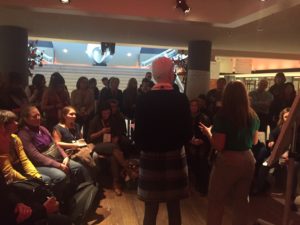
Track session 1 – Notes to self… Journey from Rookie Tester to Senior Test Automation Expert
Jani Haapala, a young test automation practitioner from Finland shared his insight into his journey from being a manual tester to an automation engineer. Comparing to a popular video game, he brought out the three levels of quests that testers have to overcome to achieve expertise in test automation. The first level is to face the monster of automation (to get the base set up in place), level two is facing the beast of mass (i.e., to ring fence the number of tests to be automated), level three being encountering beast of meaning and level four is beast of future. For each level he gave a number of useful tips and tricks. For level one he suggested assessment of requirements around automation, establishing the infrastructure, the CI pipeline and choosing the framework. He highlighted some of the pitfalls to be watchful of and emphasised how maintenance is what makes automation a beast! For level two, where testers have to deal with the volume of tests, he explained an interesting approach from his project where he would ‘jail’ the existing tests which are failing. He would further put them into ‘court’ (i.e., review the actions required to make them pass), ‘rehabilitate’ them and put them under ‘probation’ before putting them in a regression pack. For level three he suggested testers to go on a quest for information, knowledge and wisdom. i.e., to understand what the tests are telling you about the system and the requirements. For the final level, he recommended future proofing the automation approach and exploring other levels. His session was concluded by many interesting questions too.
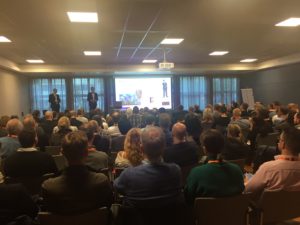
Track session # 2 – Accepting Ignorance – The Driving Force of a Good Tester
Patrick Prill, a highly experienced test consultant from Germany spoke about a philosophical take on the value of ignorance in testing. Starting from the every day terms of testing which are not clearly understood, to the business requirements, we need to value the idea of not knowing. He highlighted the importance of being aware of not knowing enough about a topic / system. “The more you know, the more you learn about what you don’t know”. Asking good question leads to ‘high quality ignorance’ which is essentially a more refined set of questions about a certain topic. The role of unknown is quite important in all key steps of a testing process which are risk assessment (risk exploration), test planning (uncovering the unknown), evolving test charters (moving the border of unknown as you discover them) and test reporting (informing others about the knowledge of unknown). He also suggested a number of ways to uncover the unknown. Not knowing is the first step to understanding he concluded. I found the session highly thought provoking and interesting.
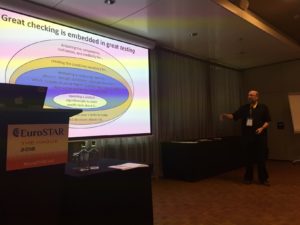
Track session # 3 – High value checking
It was a privilege to witness the testing guru Michael Bolton speaking on stage and it was incredibly engaging session. With his immense stage presence and energy level, Michael held the attention of the audience all through his session. With his inimitable sense of humour, Michael delivered a session of high impact about how we mistake checking to testing. He said confusion between the two is like mistaking between biting and eating, compiling and programming. He clarified the difference between the two – checking is more of GMPB (Getting Machines to Press Buttons!) activity where the core of the task is comparing the outcome with a set expected result whereas testing involves much more dynamic thinking around the outcome of a result. He said that checking can be performed by machines but humans are required for testing. He highlighted the importance of good quality checking and how it enhancing the effectiveness of testing – “Great checking is embedded in great testing”. He established how wrong conclusions can be drawn due to wrong checking. He went on to compare a product to be like a planet where at the core is the hardware and operating system followed by layers of app framework, sub-systems & services and UI being at the top. He highlighted how the top layer matters but the bottom layer supports it. He compared data to be like air / magma and hence quite dynamic. He compared end-to-end testing of such an arrangement to a domino game which is completely under cover where falling of the final domino need not be an indication to everything else having been successfully done – it is important to pay attention to metadata. He highlighted how brittle tools can be and hence not to focus on tests to become green but to emphasise on the learning and investigation. His session was filled with insight and impact – truly memorable.
Networking event – Women in Testing
Members of the Norwegian Testing community put together this thought provoking session on women in testing. Discussing the trends in Norway, where there is a noticeable decline in women in technology, they brought out many aspects of the topic. It was a very well attended session by men and women alike. We were given a chance to discuss in groups some pertinent topics. I was a part of a group who were discussing the topic of “do women have significant challenges in operating within technology sector? If so why are they facing difficulties and what can we do to help”. There was a spirited discussion and many thoughts were brought up by the participants. This is certainly an area that the IT industry needs to address effectively. As the organisations around the world are waking up to the need to improve diversity in work environments, this is a very current topic.
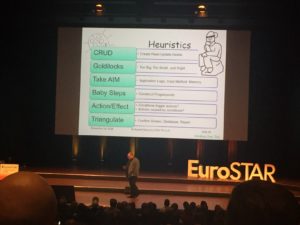
Track session #4 – Agile in formal organisation
Two testing professionals from Dutch banking sector, Egbert Bouman and Robin Esman brought out some interesting aspects around creating agile practices in a formal organisation, an experience that a lot of us can relate to i.e., the friction between agile practices and traditional organisations is well known! Egbert and Robin elaborated about how they made a successful implementation using many measures like maintaining good testing practices within scrum (like effective risk analysis), effective defect logging mechanisms (which would enable auditable governance) establishing good feedback channels for the stakeholders (like using scorecards for retrospectives), managing test automation effectively (shift left) etc. They used visual cards (called WoW cards), they created better ways to establish understanding of the agile processes for the stakeholders. They elaborated on how they used audits as a positive opportunity as it resulted in attention of management. They constantly were in pursuit to improve the improvisation by stimulating, challenging and facilitating the development process. They brought out an important point that agile can be practised in traditional organisations effectively by working around the challenges cleverly.
Key Notes session #2 – How our differences make all the difference and what to do about it
The day ended on a high for the participants with an inspirational and insightful talk by Sallyann Freudensen. She started the session by highlighting the importance of creativity and how it is negatively affected by various factors of our work environment – deadlines for example. Even in agile environments, there is a pressure on people to think on their feet which is not the way everyone works. She elaborated on the idea of neurodiversity and how being different makes us contribute on varied aspects of a work environment. For example some of us are more comfortable with repetitive tasks than the others. Diversity was the main focus of her session the importance of which she established very effectively through examples around flawed approach in recruitment. Challenging ideas like ‘one size fits all’ and the various cognitive biases we tend to have, she delivered a compelling session making us introspect about our own tendencies / pre-disposition / prejudices which come in the way of achieving diversity which is one of the key factors of any work environment. Comparing it to an under water eco system, Sallyann highlighted the need to look after the health and well being. Being an active campaigner of accessibility and diversity, this session was completely to my wavelength and I was riveted throughout the talk. Through a humorous and engaging manner Sallyann brought the spotlight on a very important aspect of today’s professional world.
As I finished for the day and left the venue, I was in a state of bliss! To have met so many interesting testing professionals, talking about topics I truly care about and to have ended the day with an awesome session about diversity, I couldn’t have asked more!